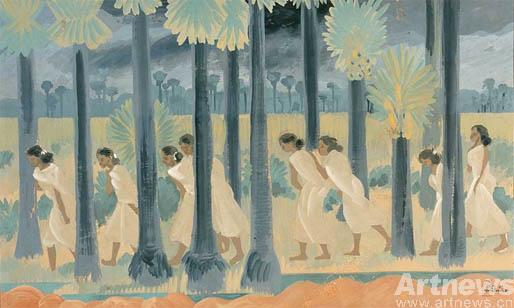|
 Nandalal Bose,新的云,纸上蛋彩画,1937年
Nandalal Bose,新的云,纸上蛋彩画,1937年
圣地亚哥讯 圣地亚哥美术馆首次组织除亚洲以外的巡回展,全面展出印度现代艺术之父Nandalal Bose(1882–1966)的戏剧节目。“印度旋律”将有近100幅Bose 的精品绘画,有多种风格和媒介。展示了他与圣雄甘地的亲密关系和对印度非暴力的运动的成功贡献。
该展览的组织者通过与印度政府和新德里国立现代画廊的通力合作,探索了印度在从英国殖民地到一个独立的国家决定性转型时期变化。这个展览也是第一次允许Bose 的作品在亚洲以外展出,展示了Bose 在一个独立的印度下为发展视觉印度现代新艺术的基础与方式。
Nandalal Bose 1882年出生在印度北部比哈尔,1905年开始了他的艺术生涯,他是许多艺术家参与甘地领导的非暴力运动和为寻找印度摆脱殖民统治和西方化理想中的一员。1919年,Bose 成为诺贝尔得主泰戈尔在孟加拉乡村建立的综合大学艺术学校的第一个主管,在那里,传统的印度技巧超过了英式教育。
San Diego Museum of Art Presents Rhythms of India: The Art of Nandalal Bose (1882-1966)
SAN DIEGO, CA.-The San Diego Museum of Art has organized the first comprehensive traveling exhibition outside of Asia to survey the expansive repertoire of Nandalal Bose (1882–1966), the father of modern art in India. Rhythms of India features close to 100 of Bose’s finest paintings, which are executed in a variety of styles and media. It also reveals how Bose contributed to the success of India’s non-violent struggle for independence from colonial rule through his close association with Mahatma Gandhi.
Organized through an unprecedented collaboration with the government of India and the National Gallery of Modern Art, New Delhi, this groundbreaking exhibition explores the crucial period of India’s transition from a British colony to an independent nation through the lens of the country’s premier artist of the time. The exhibition also marks the first time that a survey of Bose’s work has been permitted to leave Asia. The works on view reveal the way Bose contributed to the development of a new Indian art form and laid the foundation for modern visual culture in independent India.
Nandalal Bose was born in Bihar, India, in 1882. At the beginning of his career in 1905, he was one of many artists and visionaries who sought to revive the spirituality and cultural authenticity of Indian art after 50 years of colonial rule and westernization. In 1919, Bose became the first director of the art school at the new university founded by Nobel laureate Rabindranath Tagore in rural Bengal. Here, traditional Indian teaching methods were favored over British-style education.
|

